
This is an index of drinking establishment-related articles.
Contents
- Types of drinking establishment
- Lists of pubs
- Bar terminology
- Other
- A
- B
- C
- E
- G
- I
- J
- K
- L
- M
- N
- P
- R
- S
- W
- Z
- See also
- External links


This is an index of drinking establishment-related articles.

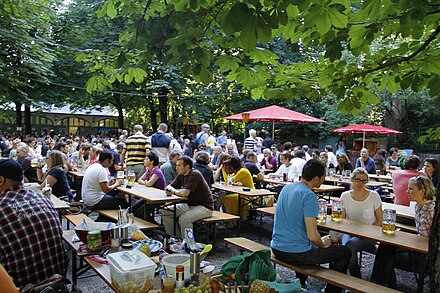

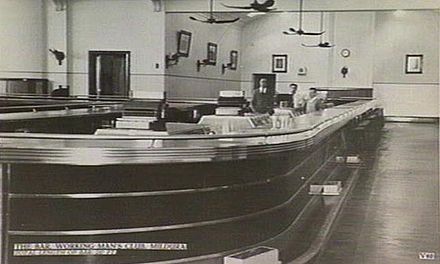


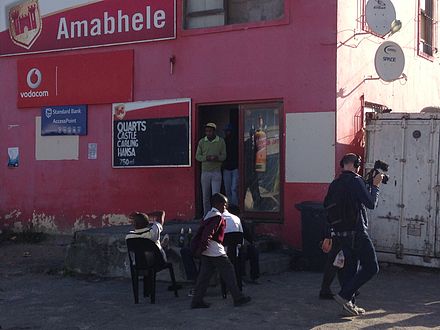

A cocktail is an alcoholic mixed drink, which is either a combination of spirits, or one or more spirits mixed with other ingredients such as fruit juice, flavored syrup, or cream. There are various types of cocktails, based on the number and kind of ingredients added. The origins of the cocktail are debated.

A pub, or public house, is an establishment licensed to serve alcoholic drinks for consumption on the premises. The term public house first appeared in the late 17th century, and was used to differentiate private houses from those which were, quite literally, open to the public as 'alehouses', 'taverns' and 'inns'. By Georgian times it had become common parlance, although taverns, as a distinct establishment, had largely ceased to exist by the beginning of the 19th century. Today, pubs have no strict definition, but CAMRA states a pub has four characteristics:
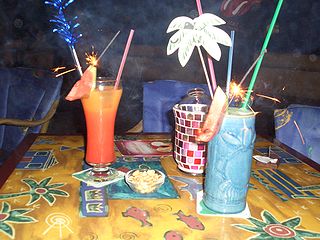
A mixed drink is a beverage in which two or more ingredients are mixed. Some contain liquor, others are non-alcoholic. A "spirit and mixer" is any combination of one spirit with one non-alcoholic component, such as gin and tonic, whereas a "cocktail" generally comprises three or more ingredients.

A tavern is a place of business where people gather to drink alcoholic beverages and be served food, and historically, where travelers receive lodging. An inn is a tavern that has a license to put up guests as lodgers. The word derives from the Latin taberna whose original meaning was a shed, workshop, stall, or pub.

A bar is a long raised narrow table or bench designed for dispensing beer or other alcoholic drinks. They were originally chest high, and a bar, often brass, ran the length of the table, just above floor height, for customers to rest a foot on, which gave the table its name. Over many years, heights of bars were lowered, and high stools added, and the brass bar remains today. The name bar became identified with the business, is a retail business establishment that serves alcoholic beverages, such as beer, wine, liquor, cocktails, and other beverages such as mineral water and soft drinks. Bars often also sell snack foods such as potato chips or peanuts, for consumption on their premises. Some types of bars, such as pubs, may also serve food from a restaurant menu. The term "bar" also refers to the countertop and area where drinks are served. The term "bar" derives from the metal or wooden bar (barrier) that is often located along the length of the "bar".

Drinking culture is the set of traditions and social behaviors that surround the consumption of beverages containing ethanol as a recreational drug and social lubricant. Although alcoholic beverages and social attitudes toward drinking vary around the world, nearly every civilization has independently discovered the processes of brewing beer, fermenting wine and distilling spirits.

A bartender is a person who formulates and serves alcoholic or soft drink beverages behind the bar, usually in a licensed establishment. Bartenders also usually maintain the supplies and inventory for the bar. A bartender can generally mix classic cocktails such as a Cosmopolitan, Manhattan, Old Fashioned, and Mojito.

In the United Kingdom, a tied house is a public house required to buy at least some of its beer from a particular brewery or pub company. That is in contrast to a free house, which is able to choose the beers it stocks freely.

Angostura bitters is a concentrated bitters based on gentian, herbs, and spices, by House of Angostura in Trinidad and Tobago. It is typically used for flavouring beverages or, less often, food. The bitters were first produced in the town of Angostura, hence the name, but do not contain angostura bark. The bottle is recognisable by its distinctive over-sized label. Angostura is Spanish for narrowing, the town of Angostura having been located at the first narrowing of the Orinoco River.
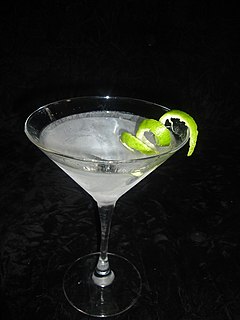
Various unique terminology is used in bartending.
Bathtub gin refers to any style of homemade spirit made in amateur conditions. The term first appeared in 1920, in the prohibition-era United States, in reference to the poor-quality alcohol that was being made.

Anju is a Korean term for food consumed with alcohol. It consists of a variety of foods, including both main dishes and side dishes. Consuming food with alcohol is a widespread practice in Korea, especially when the alcoholic beverage soju is involved.

A beer cocktail is a cocktail that is made by mixing beer with a distilled beverage or another style of beer. In this type of cocktail, the primary ingredient is beer. A mixture of beer with a beverage that contains a soft drink is usually called a shandy.

A flaming drink is a cocktail or other mixed drink that contains flammable, high-proof alcohol, which is ignited prior to consumption. The alcohol may be an integral part of the drink, or it may be floated as a thin layer across the top of the drink. The flames are mostly for dramatic flair. However, in combination with certain ingredients, the flavor of the drink is altered. Some flavors are enhanced, and it may impart a toasted flavor to some drinks.

A drinking establishment is a business whose primary function is the serving of alcoholic beverages for consumption on the premises. Some establishments may also serve food, or have entertainment, but their main purpose is to serve alcoholic beverages. There are different types of drinking establishment ranging from seedy bars or nightclubs, sometimes termed "dive bars", to 5,000 seat beer halls and elegant places of entertainment for the elite. A public house, informally known as a "pub", is an establishment licensed to serve alcoholic drinks for consumption on the premises in countries and regions of British influence. Although the terms are increasingly used to refer to the same thing, there is a difference between pubs, bars, inns, taverns and lounges where alcohol is served commercially. A tavern or pot-house is, loosely, a place of business where people gather to drink alcoholic beverages and, more than likely, also be served food, though not licensed to put up guests. The word derives from the Latin taberna and the Greek ταβέρνα/taverna.
Bartending school refers to private education businesses that teach individuals the many intricacies of serving customers alcohol from behind a bar. This includes not only classes in such topics as drinks mixology: the intricacies of mixing drinks and drink presentation, and the alcohol laws of the city and state, or province, in which the school is situated.